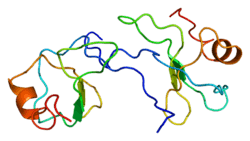CCL3
| View/Edit Human | |||
Chemokine (C-C motif) ligand 3 (CCL3) also known as macrophage inflammatory protein 1-alpha (MIP-1-alpha) is a protein that in humans is encoded by the CCL3 gene.[2]
Function
CCL3 is a cytokine belonging to the CC chemokine family that is involved in the acute inflammatory state in the recruitment and activation of polymorphonuclear leukocytes[3] through binding to the receptors CCR1, CCR4 and CCR5.[2]
Sherry et al. (1988) demonstrated 2 protein components of MIP1, called by them alpha (CCL3, this protein) and beta (CCL4).[4][2]
CCL3 produces a monophasic fever of rapid onset whose magnitude is equal to or greater than that of fevers produced with either recombinant human tumor necrosis factor or recombinant human interleukin-1. However, in contrast to these two endogenous pyrogens, the fever induced by MIP-1 is not inhibited by the cyclooxygenase inhibitor ibuprofen and CCL3 may participate in the febrile response that is not mediated through prostaglandin synthesis and clinically cannot be ablated by cyclooxygenase.[5]
Interactions
CCL3 has been shown to interact with CCL4.[6] Attracts macrophages, monocytes and neutrophils.
See also
References
- ↑ "Human PubMed Reference:".
- 1 2 3 "Entrez Gene: CCL3 chemokine (C-C motif) ligand 3".
- ↑ Wolpe SD, Davatelis G, Sherry B, Beutler B, Hesse DG, Nguyen HT, Moldawer LL, Nathan CF, Lowry SF, Cerami A (1988). "Macrophages secrete a novel heparin-binding protein with inflammatory and neutrophil chemokinetic properties". The Journal of Experimental Medicine. 167 (2): 570–81. doi:10.1084/jem.167.2.570. PMC 2188834
 . PMID 3279154.
. PMID 3279154. - ↑ Sherry B, Tekamp-Olson P, Gallegos C, Bauer D, Davatelis G, Wolpe SD, Masiarz F, Coit D, Cerami A (1988). "Resolution of the two components of macrophage inflammatory protein 1, and cloning and characterization of one of those components, macrophage inflammatory protein 1 beta". The Journal of Experimental Medicine. 168 (6): 2251–9. doi:10.1084/jem.168.6.2251. PMC 2189160
 . PMID 3058856.
. PMID 3058856. - ↑ Davatelis G, Wolpe SD, Sherry B, Dayer JM, Chicheportiche R, Cerami A (1989). "Macrophage inflammatory protein-1: a prostaglandin-independent endogenous pyrogen". Science (New York, N.Y.). 243 (4894 Pt 1): 1066–8. doi:10.1126/science.2646711. PMID 2646711.
- ↑ Guan E, Wang J, Norcross MA (Apr 2001). "Identification of human macrophage inflammatory proteins 1alpha and 1beta as a native secreted heterodimer". The Journal of Biological Chemistry. 276 (15): 12404–9. doi:10.1074/jbc.M006327200. PMID 11278300.
Further reading
- Menten P, Wuyts A, Van Damme J (Dec 2002). "Macrophage inflammatory protein-1". Cytokine & Growth Factor Reviews. 13 (6): 455–81. doi:10.1016/S1359-6101(02)00045-X. PMID 12401480.
- Muthumani K, Desai BM, Hwang DS, Choo AY, Laddy DJ, Thieu KP, Rao RG, Weiner DB (Apr 2004). "HIV-1 Vpr and anti-inflammatory activity". DNA and Cell Biology. 23 (4): 239–47. doi:10.1089/104454904773819824. PMID 15142381.
- Joseph AM, Kumar M, Mitra D (Jan 2005). "Nef: "necessary and enforcing factor" in HIV infection". Current HIV Research. 3 (1): 87–94. doi:10.2174/1570162052773013. PMID 15638726.
- Zhao RY, Elder RT (Mar 2005). "Viral infections and cell cycle G2/M regulation". Cell Research. 15 (3): 143–9. doi:10.1038/sj.cr.7290279. PMID 15780175.
- Zhao RY, Bukrinsky M, Elder RT (Apr 2005). "HIV-1 viral protein R (Vpr) & host cellular responses". The Indian Journal of Medical Research. 121 (4): 270–86. PMID 15817944.
- Li L, Li HS, Pauza CD, Bukrinsky M, Zhao RY (2006). "Roles of HIV-1 auxiliary proteins in viral pathogenesis and host-pathogen interactions". Cell Research. 15 (11-12): 923–34. doi:10.1038/sj.cr.7290370. PMID 16354571.



